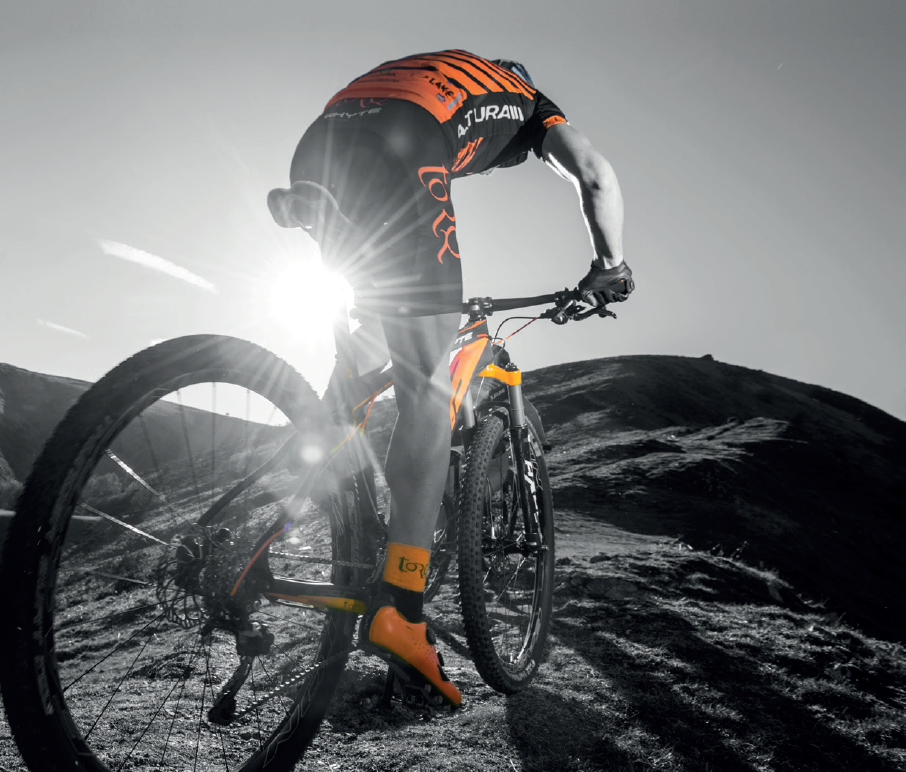
Whether it's a key race, gran fondo, multi-day training camp, or even just several days you are looking to be in top form to go the distance and achieve your goal(s), it is likely that you have thought about training, resting, and especially...'what should my diet be...?' TORQ lays out the essentials in this post and covers the basics...as well as the details to get you in top form leading into your event, and ready for the next calendar entry...
THE DAYS LEADING UP TO THE EVENT
If you’ve been training hard in the months leading up to the event, then the 7-14 days before is a key time in your event preparation to ensure that you can achieve your best performance when it counts. If you want to perform at your best on the day of the event, you’ll need to be well rested and in order to do this, you need to taper. Tapering refers to reduction in your training volume to reduce the stress that you are putting your body under and, by doing so, allow it to adapt and recover from the heavy training that you’ve been doing in the run up to the event.
Tapers should last between 7-14 days, depending on how heavily you’ve been training and how fast you recover. During a taper you need to reduce the volume of training that you are doing, either through doing less training sessions or making your usual sessions shorter. During these shorter sessions it’s important to keep some high intensity work in there so that come race/event day, riding at race pace shouldn’t come as a shock to the system and also, to prevent you losing any of the training adaptation’s that you’ve worked hard to achieve.
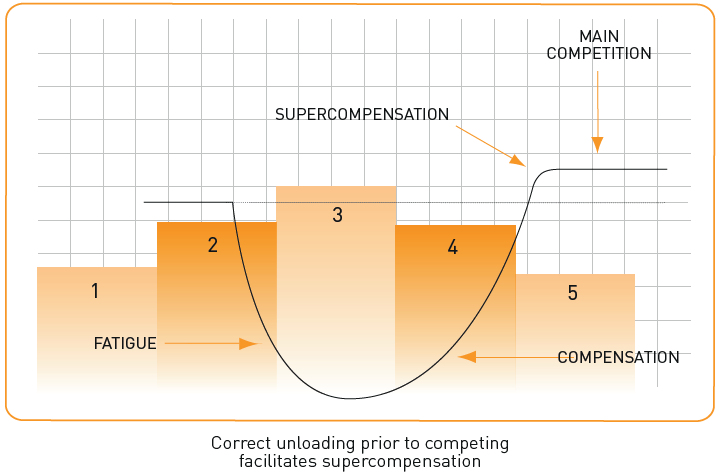
The diagram above shows what a taper should look like. The objective is that you build up a trough of fatigue by training hard (as shown in bars 1-3), then you back off your training volume into your taper on the approach to the event (weeks 4-5). By reducing your training volume, your body recovers and ‘supercompensates’ as shown by the black line. This then effectively translates into an improvement in performance as your body adapts and becomes stronger. Timing things right will allow you to take advantage of this supercompensation and ensure that you can achieve your best performances when it counts.
THE DAY BEFORE THE EVENT
2-3 days before the event there is no training session that will lead to any further improvements in your performance, although doing a shorter sharper ride will help keep you honed for race day. The focus should now move onto your nutritional preparation.
If your event is longer than around 90 minutes, then one of the key factors that will limit your performance is the amount of carbohydrate you have available to use as a fuel. The more carbohydrate you have available, the longer you’re going to last on event day and the faster you’ll be able to go.
The two ways to ensure you have plenty of carbohydrate available on race day are:
- to fuel the ride itself (which we’ll come to shortly),
- and ensuring the fuel tanks of carbohydrate (known as glycogen) in your muscles and liver are fully topped up prior to arriving on the start line, which is known as ‘carbo-loading’
Combining these two strategies will pay huge dividends and help boost your performance.
To carbohydrate load successfully, the obvious procedure would be to consume a lot of carbohydrate rich foods during the 2-3 days before the event; in absolute terms, you are looking to consume around 8-10 grams of carbohydrate per kilogram of your body weight. For a 70kg (~155lb) athlete this equates to 560-700 grams of carbohydrate. By combining a high carbohydrate intake with a taper in your training, you can increase the amount of glycogen in your muscle above normal levels, effectively super compensating your muscle glycogen stores. Successful carbohydrate loading will leave your legs feeling quite heavy on event day, but as you use the carbohydrate up (as the event unwinds) you’ll feel better and better.
When it comes to carbohydrate loading, the vast majority of your calories should be from carbohydrate rich foods, keeping protein intake moderate and fat very low. Fat will delay the absorption of carbohydrate and your event performance will never be limited by lack of fat stores, however skinny you are. You’ll need to make sure that you’re hydrated, because for every gram of carbohydrate you store, you will also retain 3 grams of water. It’s also important to avoid foods that are high in fiber (things like muesli, nuts, beans and pulses, to name but a few) as, similarly to fat, fiber will sit in your digestive tract and potentially result in stomach issues on race day.
Carbohydrates come in 2 forms: starches (polysaccharides) and sugars (mono and disaccharides). Here are some examples so that you can plan your loading effectively:
Polysaccharides: Pasta, rice, potatoes, chickpeas, lentils, bread, couscous.
Mono/Disaccharides: Sugar, wine gums, fruit pastilles, sugary drinks (non-diet), honey, jam.
Breakfast cereals tend to be a good mix of both types. In fact, there are many foods that contain both types of carbohydrate, but you just need to ensure your choices don’t contain much fat or fiber. Chocolate or cakes are bad choices for instance. The advantage of mono/disaccharides over polysaccharides from a carbo-loading perspective is that they are lower in bulk and richer in carbohydrate calories than polysaccharides. From a long-term health perspective, polysaccharides are favorable, because they contain dietary fiber, some protein and various vitamins and minerals.
TORQ products can be used as part of the carbo-loading process, because they’re rich in carbohydrate and low in fat and fiber, but it would be wrong for us to suggest that they’re going to do a better job than normal food. Where TORQ products will really help is during the event itself and immediately afterwards, which will be discussed shortly.
One product you could consider for the carbo-loading process is the TORQ Energy drink – Natural Organic Unflavored. It is a polysaccharide, but it has the density of a mono/disaccharide, which means that although it has the density and carbohydrate concentration of sugar, it has no sweetness. This product can be added to all sorts of sweet and savory foods such as cups of tea or soup, without altering the flavor. Many top athletes use it extensively as an invisible calorie to help with carbo -loading and refueling after exercise, because 3 level scoops has the same carbohydrate content as a large bowl of pasta. If this is of interest to you, please click HERE for specifics on this product.
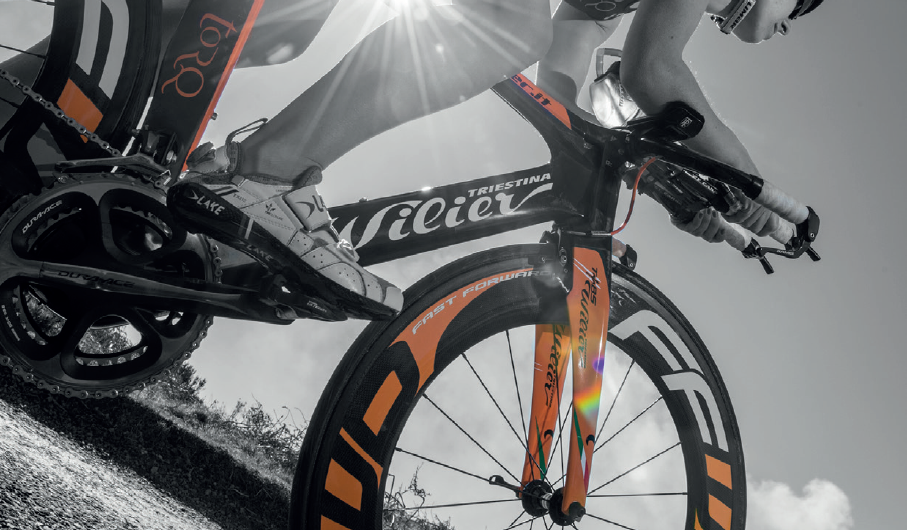
THE MORNING OF THE EVENT
If you’re tapered and carbohydrate loaded then your muscles should be fully loaded with glycogen, however, overnight your body breaks down some of your liver glycogen, so it’s important to consume a high carbohydrate breakfast 3-4 hours before the start to top these stores up and give you plenty of time to digest the meal. Again, this meal needs to be light on the stomach and low in fat and fiber. The golden rule here is to make sure you consume a meal which you are well accustomed to; never try anything new on race day and aim for around 50-100 grams of carbohydrate. If you have less than 3-4 hours then try some light, high carbohydrate snacks such as a TORQ Bar or some pretzels. It’s also a good idea to consume some lean protein at breakfast if you fancy it, because this is going to be the last satiating meal you’ll have for a while.
THE MORNING OF THE EVENT - 1HR to 'GO'
In the 1 hour before the event, it is best to avoid consuming any carbohydrate (particularly high glycaemic index carbohydrates) until you start warming up, as if you time it wrong, it can leave you feeling lackluster and unfocused on the start line. The diagram below shows how high glycaemic index carbohydrate sources will cause a rapid rise in blood glucose followed by a proportional rise in insulin, which in turn lowers blood glucose. This panic response, named ‘rebound hypoglycaemia’, actually sends blood glucose (and your mental responsiveness) to a low point and it’s not a great place to be when you’re about to start a big endurance challenge.
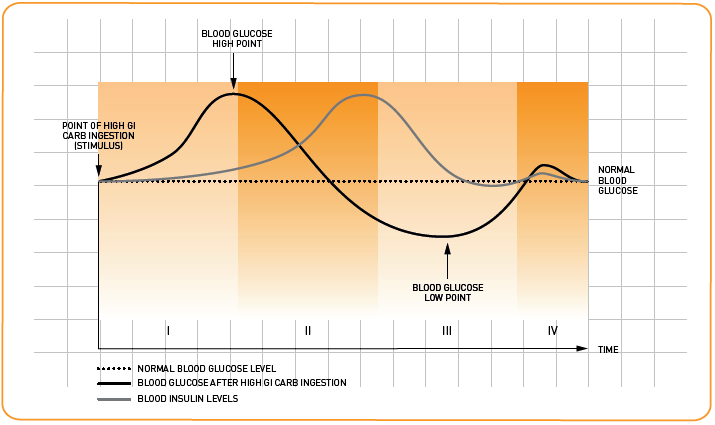
If you want to learn more about high and low glycaemic index (GI) carbohydrate sources, do a Google search, because there’s far too much information out there to put into this article, but effectively, more processed carbohydrates have a higher GI, because the body breaks them down more easily. Raw husky organic carbohydrates tend to have a lower GI.
The key reasons for avoiding fat and fiber before a big event are that they slow the passage of food through the gut and impede the absorption of carbohydrate, both nutrients are also associated with stomach problems on race day, none of which is a good thing. In addition to this, if you have a fatty breakfast, you could start taking the perfect energy products on board from the start of your ride and they’ll all sit on top of this plug of fat. You’ll struggle to digest the good stuff and then you’ll feel nauseous and get all sorts of gastric problems. This won’t be because of the energy products you’ve consumed; it’ll be due to your earlier fat intake.
It’s important to note here that fat does carry certain essential omega oils and vitamins A, D, E and K, which are fat-soluble, and fiber is also an important dietary nutrient so you certainly don’t want to omit fat or fiber from your diet altogether, but you don’t need it on event morning or, as you’ll read in the next section, during the event itself.
As an aside, an excellent TORQ-recommended pre-event breakfast is a bowl of oatmeal (rolled oats, or even instant!) with banana/berries, and some non-fat Greek yogurt. Another is even simply a bagel or slices of toast with poached egg to get some lean protein. One of our secrets is actually an everything bagel, sans butter or cream-cheese, with banana spread over with spicy jelly, or add veg and locks. Winner. This ticks all the boxes as far as we’re concerned.
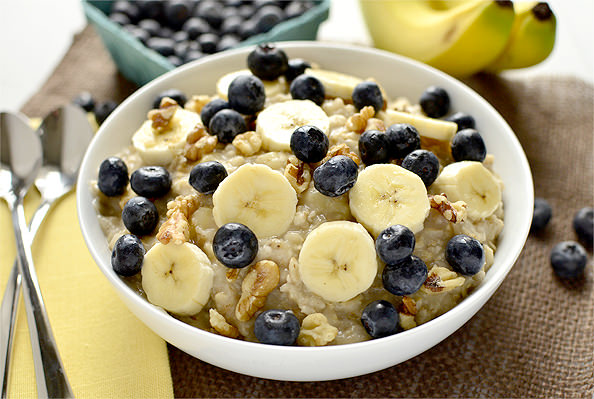
Above: a perfect pre-race breakfast a couple hours before event. Rolled oats (oatmeal), fresh fruit (bananas, blueberries, strawberries, etc), some nuts (for light protein, not too much fiber), and of course, a cup of coffee (not pictured).
DURING THE EVENT
It’s during the event where TORQ products are meant to be used. You could use low fat forms of carbohydrate like jelly beans and prunes as fuel, because these are essentially delivering carbohydrate to your blood stream, but this isn’t an optimal approach and quite frankly, we wouldn’t have a business if our products couldn’t do a significantly better job and get you home quicker and more comfortably.
Before the turn of the millennium, research had proven that glucose-based products delivered energy more quickly than any other whilst exercising and, specifically, a special polymer of glucose called ‘Maltodextrin’. Using maltodextrin-based products, it was deemed possible to deliver approximately 60 grams of carbohydrate per hour, which basically meant that 60 grams of stored carbohydrate were ‘spared’ per hour of exercise. As carbohydrate is stored in limited supply within the working muscles, fueling at this rate was (and still is) considered to be hugely beneficial to endurance performance.
In 2005, new research found that by mixing maltodextrin with fructose (fruit sugar) at a 2:1 ratio, carbohydrate delivery was increased by 40% and this had huge implications for the prescription of fueling for endurance events. This, and other studies, suggest that a 2:1 maltodextrin:fructose formulation allows the user to consume and use up to 90 grams of carbohydrate per hour. The implications of being able to deliver and use 30 grams more carbohydrate than previously considered possible are of great significance to endurance performance. In short, it gives you 40% better carbohydrate-sparing than using maltodextrin alone, which is quite a staggering finding. This extremely fast delivery of carbohydrate also means that the product isn’t in the gut for long, so stomach problems from these formulations are extremely rare. Suffice to say, all TORQ’s Energy products are formulated using 2:1 maltodextrin: fructose and, to further ease gastric emptying, the philosophy of the company is very much about keeping the products natural. We have Soil Association Organic and Fairtrade Certification on many of our products.
So, whether you decide to use TORQ, another brand, or just jelly babies for your event, you should be taking on board a minimum of 40 grams of carbohydrate per hour, up to a maximum of 90 grams per hour depending on your fuel choice. Let’s assume, for the sake of argument, that you are in fact going to use TORQ for your event and it’ll make the following example much easier to explain. TORQ products have been designed in 30 gram doses to make life easier for everyone:
500ml TORQ Energy (6% recommended mix) = 30 grams carbohydrate (1 TORQ unit)
1 X TORQ Gel = 30 grams carbohydrate (1 TORQ unit)
1 X TORQ Bar = 30 grams carbohydrate (1 TORQ unit)
1 X TORQ Chew = 30 grams carbohydrate (1 TORQ unit)
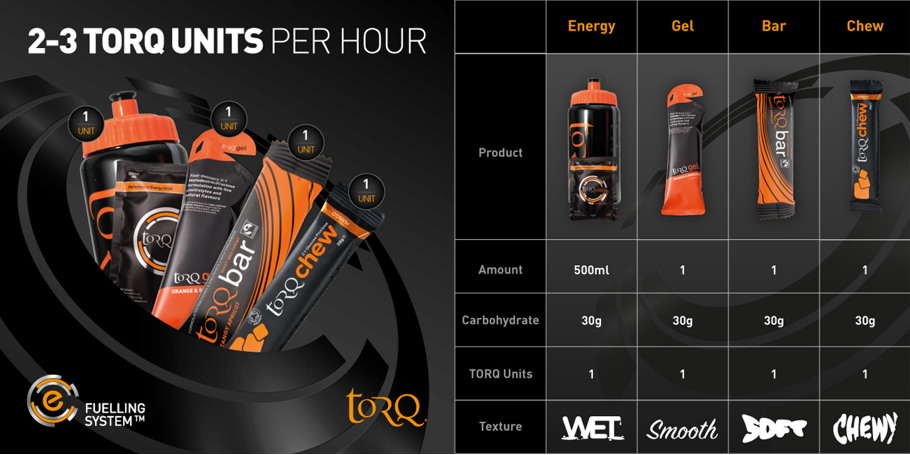
Let’s further assume that you want to err on the side of caution for your first event and use 60 grams of carbohydrate per hour instead of 90. This means that you need to consume 2 TORQ units per hour, but which units do you take? Dehydration beyond 2% of body weight will have a negative effect on performance, particularly in hot conditions, so drinking enough is also clearly a consideration.
In a nutshell, if perspiration rates are high, more of your TORQ units should come from Energy drinks as opposed to Bars or Gels. When perspiration rates are lower, trying to drink excessive amounts of fluid or sports drinks will quite simply start to fill your bladder too quickly and, if you have to stop too often, you’re not going to get a very good performance! You’ll also find that when sweat rates are lower, that you’re just not as thirsty and therefore, the Energy drinks you have in your bottle will no doubt just stay there and, as a result, you won’t be consuming enough fuel! Whether you take a Bar, Chew or a Gel is up to you as they will all deliver carbohydrate at the same speed. A Bar or a Chew will feel more like ‘food’ if your stomach is asking for something to work on, but Gels are much easier to get down in a hurry and will make you feel less full than a Bar or Chew.
Our suggestion is that you start with 2 TORQ units per hour and then practice with 3. If you’re used to consuming energy products, then you really shouldn’t have a problem with 3 TORQ units per hour.
- Consuming 1x TORQ Energy Drink (16-20oz) throughout each hour, and complimenting with 1 TORQ Gel/Bar/Chew (pick one) is a GO-TO strategy for anyone racing >90minutes as a starting place.
For further information on the TORQ Fueling System you can follow this link: TORQ FUELING SYSTEM
This probably doesn’t need repeating, but it’s important to reiterate the ‘low fat, protein and fiber’ discussion point from the previous section, because any fat, protein or fiber consumed during the ride will affect:
a) Carbohydrate delivery
b) Gastrointestinal comfort
c) Performance (the sum of the above 2 factors)
So, if an energy bar has a chocolate or yogurt coating, it will be quite high in fat and therefore we don’t consider it an energy bar. There are also plenty of apparently healthy flapjack-type products on the market masquerading as ‘energy bars’, so CHECK THE FAT CONTENT.
The final point to get across is that you should follow a plan; to maximize performance you need to be on top of your fueling and hydration from start to finish. The carbohydrate calories you take on board at the start of the ride will save you towards the end. If you run out of carbohydrate, it’s a phenomenon known as ‘hitting the wall’ or ‘bonking’ and it’s not very pleasant at all. If you’ve carb-loaded and fueled properly throughout however, ‘hitting the wall’ is almost impossible, so do the right thing.
It’s also very much worth noting that all of the above information covering this optimal fueling approach ideally needs to be applied to your training leading up to events. This is for a number of reasons. Firstly, if you fuel well during training sessions, you will enable yourself to take on a greater training load, which in turn creates more physical stress, and then forces greater adaptation, providing you rest and recover, so you will achieve greater fitness. Secondly, you get to fine tune and practice your fueling strategy and find what works for you, which links into another important reason – your digestion adapts to enable you to use the fuel and remain comfortable. If you do all your training with a lot less fuel or none, then attempt to hit 60-90 grams of carbohydrate on race day, as you know you want to perform well, then that is a lot to ask of your body, and it’s very likely you will not achieve it, and possibly feel discomfort.
AFTER THE EVENT
One school of thought is that once you’ve finished your event, you have every reason to reward yourself with a beer and some high fat indulgences. Whilst we can’t argue with this perspective, there is a compromise. Within 15 minutes of finishing, you should ideally consume a proper recovery drink, because the correct nutrients at this time will perform a huge amount of work and it’ll mean that you’ll be able to walk and function relatively normally the following day.
Once you’ve absorbed your recovery drink, hey of course, chill out, have a beer and eat some of the stuff you’ve not been allowed to for the last couple of days.
The main function of a recovery drink is to restore muscle carbohydrate (glycogen) levels to normal as soon as possible, enabling you to exercise again sooner. Other components within a good quality recovery drink will aid muscular/biochemical repair and support your immune system. Our opinion is that recovery drinks are best used during high load periods of training (like you might have done in the lead up to this event), or for multi-day events, because they increase your resilience to training and allow you to perform a higher training volume. After an event like this, they certainly help you to feel less fatigued the next day, but presumably you’ll be giving yourself a few days off anyway as a reward, so how necessary is it? The choice is yours.
Once again, there’s the subject of fat content. If a recovery product is high in fat, it’s going to delay carbohydrate and protein absorption and the whole point of a recovery drink is to get the correct mix of calories into your blood quickly whilst enzyme activity is elevated (enzymes are the chemicals within your body that do the graft of storing and building). TORQ recovery has ~0.5g fat per serving powder, which is extremely low fat.
TORQ recovery also contains whey protein to facilitate carbohydrate absorption as well as providing the building blocks for muscular repair and Ribose and L-Glutamine, which are extremely potent natural ingredients specifically chosen for their recovery/immune enhancing properties.
And of course, we have a simple to follow video, tying this all together!
All in all, the first step to proper recovery is proper fueling. This is critical in heavy training periods or multi-day events. Stick to the TORQ Fueling & Recovery Systems and you won't be steered wrong, and you will be #UNBONKABLE to acheive your goals.
For any questions on Key Event Preparation or Training Nutrition, contact:
TORQ USA
info@torqusa.com

